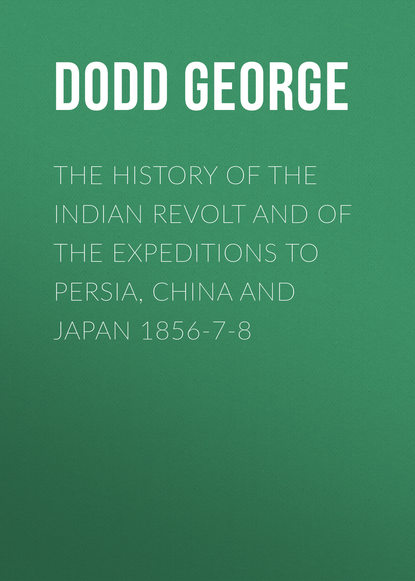По всем вопросам обращайтесь на: info@litportal.ru
(©) 2003-2024.
✖
The History of the Indian Revolt and of the Expeditions to Persia, China and Japan 1856-7-8
Настройки чтения
Размер шрифта
Высота строк
Поля
32
The brigadier’s confidence in his men was conditional on their implicit obedience; and he was wont to affirm that his ‘Irregulars’ were as ‘regular’ in conduct and discipline as the Queen’s Life-guards themselves. He would allow no religious scruples to interfere with their military efficiency. On one occasion, during the Mohurram or Mohammedan religious festival in 1854, there was great uproar and noise among ten thousand Mussulmans assembled in and near his camp of Jacobabad to celebrate their religious festival. He issued a general order: ‘The commanding officer has nothing to do with religious ceremonies. All men may worship God as they please, and may act and believe as they choose, in matters of religion; but no men have a right to annoy their neighbours, or to neglect their duty, on pretence of serving God. The officers and men of the Sinde Horse have the name of, and are supposed to be, excellent soldiers, and not mad fakeers… He therefore now informs the Sinde Irregular Horse, that in future no noisy processions, nor any disorderly display whatever, under pretence of religion or anything else, shall ever be allowed in, or in neighbourhood of, any camp of the Sinde Irregular Horse.’
33
34
35
36
In August 1857, of the whole railway distance marked out from Alexandria through Cairo to Suez, 205 miles in length, about 175 miles were finished – namely, from Alexandria to the crossing of the Nile, 65 miles; from the crossing of the Nile to Cairo, 65 miles; from Cairo towards Suez, 45 miles. The remainder of the journey consisted of 30 miles of sandy desert, not at that time provided with a railway, but traversed by omnibuses or vans.
37
‘According to existing regulations of some years’ standing, every soldier on his arrival in India is provided with the following articles of clothing, in addition to those which compose his kit in this country:
‘Mounted Men. – 4 white jackets, 6 pair of white overalls, 2 pair of Settringee overalls, 6 shirts, 4 pair of cotton socks, 1 pair of white braces.
‘Foot-soldiers. – 4 white jackets, 1 pair of English summer trousers, 5 pair of white trousers, 5 white shirts, 2 check shirts, 1 pair of white braces.
‘These articles are not supplied in this country, but form a part of the soldier’s necessaries on his arrival in India, and are composed of materials made on the spot, and best suited to the climate.
‘During his stay in India, China, Ceylon, and at other hot stations, he is provided with a tunic and shell-jacket in alternate years; and in the year in which the tunic is not issued, the difference in the value of the two articles is paid to the soldier, to be expended (by the officer commanding) for his benefit in any articles suited to the climate of the station.
‘The force recently sent out to China and India has been provided with white cotton helmet and forage-cap covers.
‘Any quantity of light clothing for troops can be procured on the spot in India at the shortest notice.’
38
The troops at Umballa on the 17th comprised:
39
40
Four guns of Major Tombs’ horse-artillery.
Major Scott’s horse field-battery.
Two 18-pounders, under Lieutenant Light.
Two squadrons of Carabiniers.
Six companies of 60th Rifles.
400 Sirmoor Goorkhas.
41
Head-quarters and six companies of H.M. 60th Rifles.
Head-quarters and nine companies of H.M. 75th foot.
1st Bengal European Fusiliers.
2d Bengal European Fusiliers head-qurs. and six companies.
Sirmoor battalion (Goorkhas), a wing.
Head-quarters detachment Sappers and Miners.
H.M. 9th Lancers.
H.M. 6th Dragoon-guards (Carabiniers), two squadrons.
Horse-artillery, one troop of 1st brigade.
Horse-artillery, two troops of 3d brigade.
Foot-artillery, two companies, and No. 14 horse-battery.
Artillery recruits, detachment.
42
Chapter iv., pp. 63 (#x_14_i17)-65 (#x_14_i25).
43
After the execution of Mungal Pandy at Barrackpore on the 8th of April, for mutiny, the rebel sepoys acquired the soubriquet of ‘Pandies’ – especially those belonging to the Brahmin caste.
44
Besides these effectives, there were as non-effectives, 765 sick + 351 wounded = 1116.
45
Bengal native infantry: 3d, 9th, 11th, 12th, 15th, 20th, 28th, 29th, 30th, 36th, 38th, 44th, 45th, 54th, 57th, 60th, 61st, 67th, 68th, 72d, 74th, 78th.
Other native infantry: 5th and 7th Gwalior Contingent, Kotah Contingent, Hurrianah battalion; together with 2600 miscellaneous infantry.
Native cavalry: Portions of five or six regiments, besides others of the Gwalior and Malwah Contingents.
46
It may be useful to note, for readers unfamiliar with military matters, the meaning of the words brevet and brigadier. A brevet is a commission, conferring on an officer a degree of rank next above that which he holds in his particular regiment; without, however, conveying the power of receiving the corresponding pay. Besides being honorary as a mark of distinction, it qualifies the officer to succeed to the full possession of the higher rank on a vacancy occurring, in preference to one not holding a brevet. In the British army brevet rank only applies to captains, majors, and lieutenant-colonels. A brigadier is a colonel or other officer of a regiment who is made temporarily a general officer for a special service, in command of a brigade, or more than one regiment. It is not a permanent rank, but is considered as a stepping-stone to the office of major-general. Many Indian officers who were colonels when the Indian mutiny began, such as Henry Lawrence and Neill, were appointed brigadier-generals for a special service, and rose to higher rank before the mutiny was ended.





